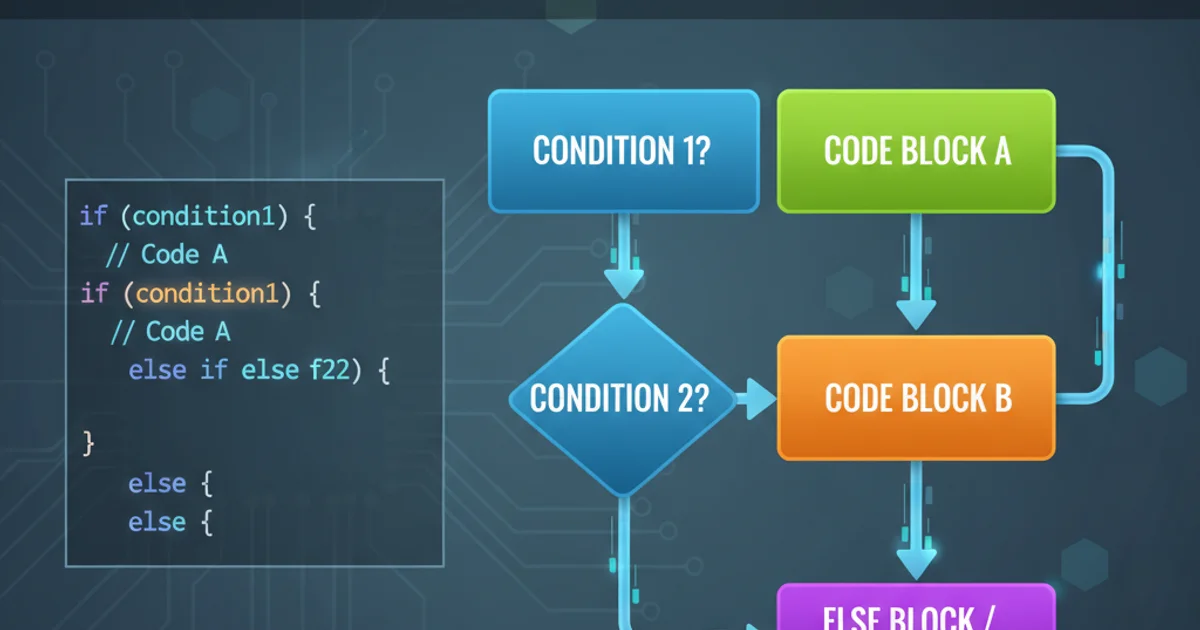Does an else if statement exist?
Categories:
Understanding the 'else if' Construct in Programming Languages

Explore the semantics and common usage of the 'else if' construct across various programming languages, clarifying its role in conditional logic.
The if-else if-else construct is a fundamental building block of conditional logic in nearly all procedural programming languages. While many languages don't have a distinct keyword else if in the same way they have if or else, the combination of an else clause immediately followed by an if statement is so common and semantically distinct that it's often referred to as a single 'else if' statement. This article delves into how this construct works, why it's used, and its implications for code readability and execution flow.
The Semantics of 'else if'
In most C-style languages (C, C++, Java, JavaScript, C#, etc.), an else block can contain any single statement. When that statement is another if statement, it creates the else if pattern. The key semantic point is that the else part is only executed if the preceding if condition (and any preceding else if conditions) evaluates to false. When an if statement is nested directly within an else block, its condition is only checked if the outer if (or else if) condition was not met. This creates a chain of mutually exclusive conditions.
if (condition1) {
// Code to execute if condition1 is true
}
else if (condition2) { // This is effectively 'else { if (condition2) { ... } }'
// Code to execute if condition1 is false AND condition2 is true
}
else if (condition3) {
// Code to execute if condition1 is false AND condition2 is false AND condition3 is true
}
else {
// Code to execute if all preceding conditions are false
}
Typical if-else if-else structure in C-like languages
flowchart TD
A[Start]
A --> B{Condition 1?}
B -- True --> C[Action 1]
B -- False --> D{Condition 2?}
D -- True --> E[Action 2]
D -- False --> F{Condition 3?}
F -- True --> G[Action 3]
F -- False --> H[Default Action]
C --> I[End]
E --> I
G --> I
H --> IExecution flow of an if-else if-else chain
Why Use 'else if' Instead of Separate 'if' Statements?
The primary reason to use else if over a series of independent if statements is to ensure mutual exclusivity and efficiency. When you use else if, only one block of code within the entire chain will ever execute. As soon as a condition evaluates to true, its corresponding block is executed, and the rest of the else if chain is skipped. This is crucial when conditions are related or when only one outcome is desired from a set of possibilities.
Consider the difference: with separate if statements, the program would evaluate every single if condition, even if an earlier one was true. With else if, evaluation stops at the first true condition, leading to more efficient code and preventing unintended side effects from multiple conditions being met.
int x = 10;
// Using else if (mutually exclusive)
if (x > 5) {
printf("x is greater than 5\n");
}
else if (x > 0) {
printf("x is greater than 0\n"); // This will NOT execute
}
// Using separate if statements (not mutually exclusive)
if (x > 5) {
printf("x is greater than 5\n"); // This will execute
}
if (x > 0) {
printf("x is greater than 0\n"); // This will ALSO execute
}
Comparison of else if vs. separate if statements
switch statement can often be a more readable and sometimes more performant alternative to a long if-else if chain.Language-Specific Nuances
While the concept is universal, the exact syntax and terminology can vary slightly. In Python, for example, the construct is explicitly elif. In shell scripting, it's elif or elif then. Regardless of the keyword, the underlying logic of chaining conditional checks where only one branch executes remains consistent.
Python
x = 10
if x > 15: print("x is greater than 15") elif x > 5: print("x is greater than 5 but not 15") else: print("x is 5 or less")
Bash Script
#!/bin/bash
x=10
if (( x > 15 )); then echo "x is greater than 15" elif (( x > 5 )); then echo "x is greater than 5 but not 15" else echo "x is 5 or less" fi